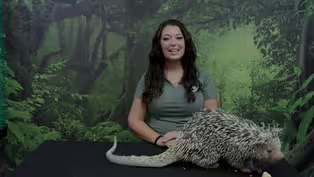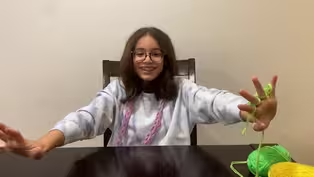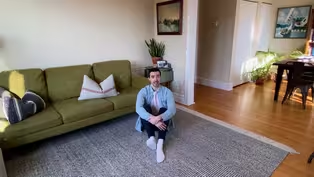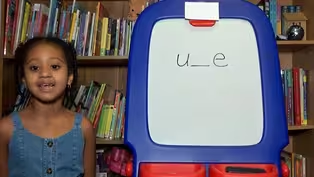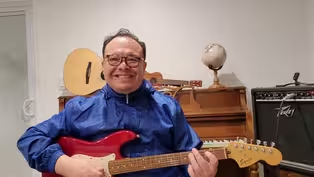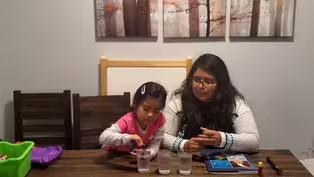
COLORED LIGHT PATTERNS
Clip: 5/5/2023 | 5m 57sVideo has Audio Description, Closed Captions
Zoe Kleinmann and a student make a pattern of light with translucent cups.
Zoe Kleinmann and a student explore patterns. First they create units of two connected plastic cubes to create an AB pattern. Then they make patterns by shining a flashlight through translucent cups of different colors.
See all videos with Audio DescriptionADProblems playing video? | Closed Captioning Feedback
Problems playing video? | Closed Captioning Feedback
Let's Learn is a local public television program presented by THIRTEEN PBS

COLORED LIGHT PATTERNS
Clip: 5/5/2023 | 5m 57sVideo has Audio Description, Closed Captions
Zoe Kleinmann and a student explore patterns. First they create units of two connected plastic cubes to create an AB pattern. Then they make patterns by shining a flashlight through translucent cups of different colors.
See all videos with Audio DescriptionADProblems playing video? | Closed Captioning Feedback
How to Watch Let's Learn
Let's Learn is available to stream on pbs.org and the free PBS App, available on iPhone, Apple TV, Android TV, Android smartphones, Amazon Fire TV, Amazon Fire Tablet, Roku, Samsung Smart TV, and Vizio.
Providing Support for PBS.org
Learn Moreabout PBS online sponsorship[upbeat music] - Hi everyone, welcome to my classroom.
I'm Miss Zoe, and I'm so excited you're here.
Today, we are going to learn about patterns.
We are going to learn about AB unit patterns.
We'll get a little more into that later.
But our class has really been focusing on transparent, translucent, and opaque items.
Now, transparent means if you shine a light through it, all the light passes through the item.
So for instance, here's a glass.
If I were to shine light through the glass, it just goes right through.
So like your windows at home are transparent.
Then we're talking about translucent.
Translucent items are things that some light passes through.
So here I have my rainbow blocks in my classroom, and here's a yellow rainbow block.
So if I shine my light through, some of the light gets through.
So, opaque things means no light gets through it.
So if I were to shine light at this cardboard, it would not go through.
You can't see it on the other end.
So today, we are going to use different color hard plastic cups.
We have red, blue, green, and yellow.
We are gonna talk about an AB pattern.
So a pattern is something that repeats itself, but how do you know it repeats itself?
So when I say an AB pattern, red would be A, yellow would be B.
A, B, A, B, A, B.
Red would be A, yellow would be B.
So that's an AB pattern.
So A and B repeat itself over and over.
So, today's activity with our translucent cups, we are gonna create an AB pattern with our cups, and then we are going to shine the flashlight to see if it really is translucent, and we can see the color pattern using the flashlight.
All right, so, like I said, I have, who's with me today?
- Renee.
- Renee.
And we're gonna work together making awesome patterns.
So, Renee, we've been talking about AB patterns, right?
So two colors.
We're gonna use two colors today, the red is A, the yellow is B, so A, B, A, B, A, B.
Red, yellow, red, yellow, red, yellow.
So, the unit that repeats itself is red and yellow, right?
So this is one unit.
Can you break it up?
All right, so there's one unit.
Here's another unit.
Can you break up another unit and put it there?
So that's two units.
And the last one is our third unit.
So we have, can you count how many units we have?
- [Renee] One, two, three.
- That's right.
So it's an AB pattern, meaning A and B repeat itself.
Red, yellow, red, yellow, red, yellow.
So today, Renee, since we've been learning all about light and translucent light, we are going to use colored cups.
Is that exciting?
And flashlights.
Okay, so why don't we come over to our special pattern board.
So let's see if we can make that AB red yellow pattern with these cups, go ahead.
Yellow.
Good.
What comes next?
What comes next in our pattern?
Okay, put it down, red.
What comes after red?
- [Renee] Yellow.
- [Zoe] Yellow.
Then?
All right, one more.
Yellow, great.
So now, just like our pattern stick, we have red, yellow, red, yellow, red, yellow.
So now, let's see if this is really translucent.
Let's see if some light comes by.
Red, yellow, red, yellow, red.
Okay, Renee.
Now can you create an AB pattern with different colors?
- [Renee] Green.
- [Zoe] Green.
Then what comes next?
- [Renee] Blue.
- [Zoe] Blue, and then what comes next?
- [Renee] Green.
- [Zoe] Green.
Green.
Now can you say the pattern?
- [Renee] Green, blue, green, blue, green, blue.
- [Zoe] Great, so the unit is green and blue.
Green and blue repeats itself.
Green, blue, green, blue, green, blue.
- All right, everyone.
So today what great fun we had creating AB patterns with light, right?
Translucent cups, shining them through different colors and making AB patterns, two color patterns.
Bye!
- Bye.
Video has Audio Description, Closed Captions
Clip: 5/5/2023 | 8m 59s | Devon Ritter from the Memphis Zoo explores the relationship animals have to light. (8m 59s)
DAHLIA SHOWS HOW TO FINGER KNIT!
Video has Audio Description, Closed Captions
Clip: 5/5/2023 | 1m 19s | Dahlia shows how to finger knit. (1m 19s)
Video has Audio Description, Closed Captions
Clip: 5/5/2023 | 10m 56s | Aaron Umsted prompts children to tap their feet up and down like a light switch. (10m 56s)
Video has Audio Description, Closed Captions
Clip: 5/5/2023 | 8m 18s | Anna Scretching-Cole explores the long u vowel sound. (8m 18s)
Video has Audio Description, Closed Captions
Clip: 5/5/2023 | 9m 43s | David Martinez prompts viewers to sing loudly and softly using colored lights. (9m 43s)
Video has Audio Description, Closed Captions
Clip: 5/5/2023 | 11m 8s | With her daughter Katherine Rodriguez reads A RAY OF LIGHT by Walter Wick. (11m 8s)
Providing Support for PBS.org
Learn Moreabout PBS online sponsorshipSupport for PBS provided by:
Let's Learn is a local public television program presented by THIRTEEN PBS
